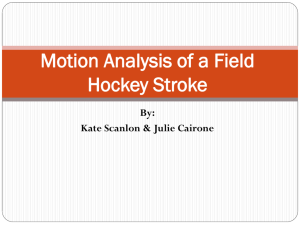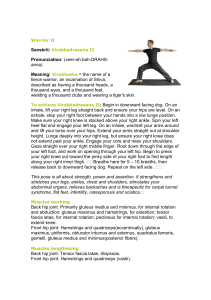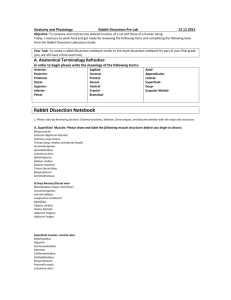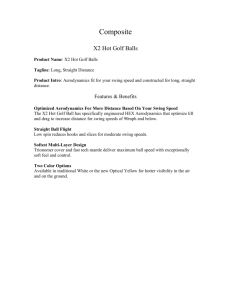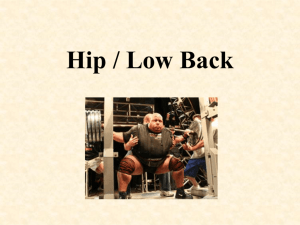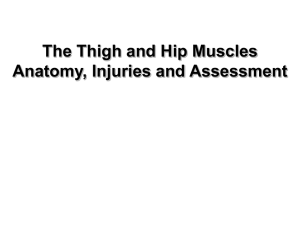Muscular Analysis Golf Swing
advertisement
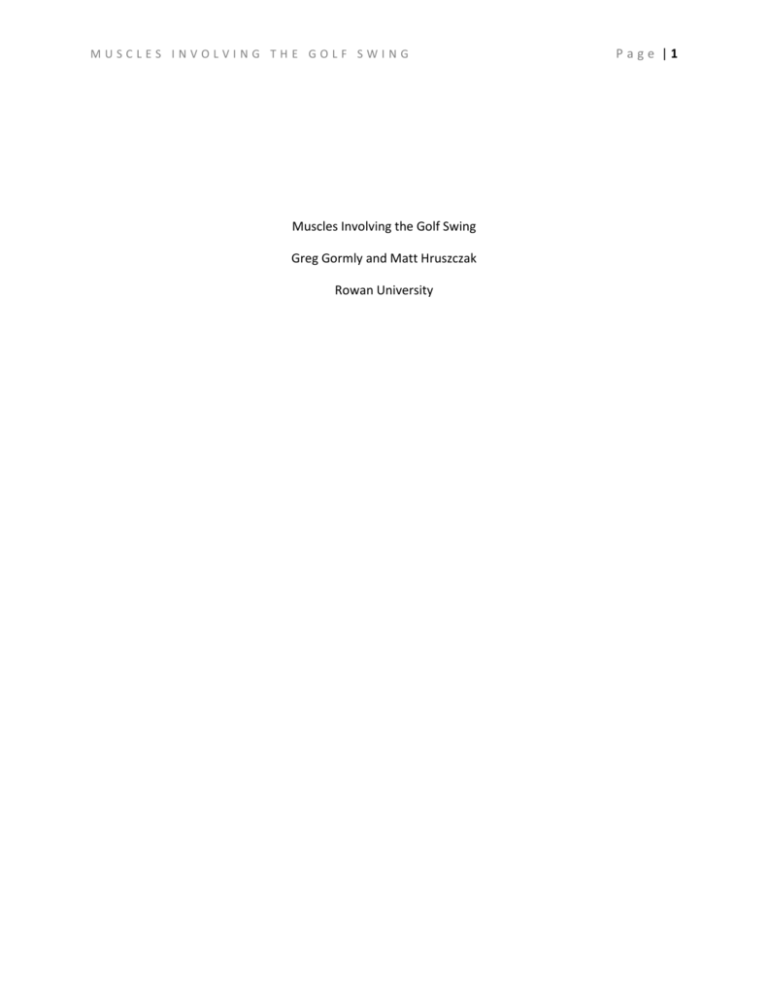
MUSCLES INVOLVING THE GOLF SWING Muscles Involving the Golf Swing Greg Gormly and Matt Hruszczak Rowan University Page |1 MUSCLES INVOLVING THE GOLF SWING Page |2 Abstract The golf swing has five phases which include the back swing, forward swing, acceleration, early follow through and late follow through. Throughout these stages different muscles are being used at different percentages of power to be combined into the perfect swing. All of these muscles are important for having a good and consistent golf swing and without any one of them it would not be possible. MUSCLES INVOLVING THE GOLF SWING Page |3 The golf swing is a complex motion involving numerous muscles of the human body. It has numerous phases including the back swing, forward swing, acceleration, early follow through and late follow through. In each of these phases, different muscles are being used at different percentages of power. In the back swing stage, the erector spinae, abdominal oblique, semimembranosus, long head of the biceps femoris are being used. In the forward swing, the vastus lateralis, adductor magnus, upper and lower gluteus maximus, biceps femoris are being used. For the acceleration stage the biceps femoris, upper and lower gluteus maximus, vastus lateralis, abdominal oblique, gluteaus medius are being used. For the early follow through the long head of biceps femoris, vastus lateralis, gluteus medius, abdominal oblique are being used. For the late follow through the semimembranosus and vastus lateralis, adductor magnus, vastus lateralis, gluteus medius are being used. All of these muscles are important for having a good and consistent golf swing and without them it would not be possible. The first stage of the golf swing is the back swing. In this stage there are four muscles involved including the erector spinae, abdominal oblique, semimembranosus and the long head of the biceps femoris. The left lower body/trunk includes the erector spinae and the abdominal oblique. The right lower body/trunk includes the Semimembranosus and the long head of the biceps femoris. For the left lower body/trunk side, the erector spinae is being worked at 26% and the abdominal oblique is being worked at 24%. For the right lower body/trunk side, the semimembranosus is being worked at 28% and the long head of the biceps femoris is being worked at 27%. MUSCLES INVOLVING THE GOLF SWING Page |4 (Dave, January 5 2010) The erector spinae actions include extension of the spine, anterior pelvic rotation, lateral flexion of the spine, lateral pelvic rotation to contralateral side and ipsilateral rotation of the spine and head. The abdominal oblique actions include lumbar flexion, posterior pelvic rotation lumbar lateral flexion to ipsilateral side, lateral pelvic rotation to contralateral side and lumbar rotation to contralateral side. (R.T. Floyd, 2012) The semimembranosus actions include flexion of the knee, extension of the hip, internal rotation of the hip and internal rotation of the knee. The biceps femoris actions include flexion of the knee, extension of the hip, external hip rotation and external knee rotation. (R.T. Floyd, 2012) The second stage of the golf swing is the forward swing. In this stage there are four muscles involved including the vastus lateralis, adductor magnus, upper and lower gluteus maximus , biceps femoris. The left lower body/trunk includes the vastus lateralis and the MUSCLES INVOLVING THE GOLF SWING Page |5 adductor magnus. The right lower body/trunk includes the upper and lower gluteus maximus and the biceps femoris. For the left lower body/trunk side the vastus lateralis is being worked at 88% and the adductior magnus is being worked at 63%. For the right lower body/trunk side the upper and lower gluteus maximus is being worked at 100% and 98% and the biceps femoris is being worked at 78%. (Dave, January 5 2010) The vastus lateralis actions include extension of the knee. The adductor magnus actions include adduction of the hip, external rotation as the hip adducts and extension of the hip. The gluteus maximus actions include extension of the hip and external rotation of the hip. The biceps femoris actions include flexion of the knee, extension of the hip, posterior pelvic rotation, external knee rotation and external rotation of the hip. (R.T. Floyd, 2012) MUSCLES INVOLVING THE GOLF SWING Page |6 The third stage of the golf swing is the acceleration. In this stage there are five muscles involved including the biceps femoris, upper and lower gluteus maximus, vastus lateralis, abdominal oblique, and gluteaus medius are being used. The left lower body/trunk includes the biceps femoris, upper and lower gluteus maximus, and vastus lateralis. The right lower body/trunk includes the abdominal obliques along with the gluteaus medius. For the left lower body/trunk side, the biceps femoris is being worked at 83%, the gluteus maximus is being worked at about 40%, and the vastus lateralis is being worked at 58%. For the right lower body/trunk side, the abdominal obliques are being worked at 59% while the gluteaus medius is being worked at 51%. (Dave, January 5 2010) The biceps femoris actions include flexion of the knee, internal rotation of the knee, extension of the hip, and internal rotation of the hip. The upper and lower gluteus maximus MUSCLES INVOLVING THE GOLF SWING Page |7 actions include extension of the hip and external rotation of the hip. The vastus lateralis creates extension of the knee. (R.T. Floyd, 2012) The abdominal oblique actions include lumbar flexion, posterior pelvic rotation lumbar lateral flexion to ipsilateral side, lateral pelvic rotation to contralateral side and lumbar rotation to contralateral side. Gluteaus medius actions include abduction of the hip; anterior fibers contribute to internal rotation of the hip and flexion of the hip while posterior fibers contribute to external rotation of the hip and extension of the hip. (R.T. Floyd, 2012) The fourth stage of the golf swing is the early follow through. In this stage there are four muscles involved including the long head of biceps femoris, vastus lateralis, gluteus medius, and abdominal oblique are being used. The left lower body/trunk includes the long head of biceps femoris and the vastus lateralis. The right lower body/trunk includes the gluteus medius and the abdominal oblique. For the left lower body/trunk side, the long head of biceps femoris is being worked at 79% and the vastus lateralis is being worked at 59%. For the right lower body/trunk side, the gluteus medius is being worked at 59% and the abdominal oblique is being worked at 51%. MUSCLES INVOLVING THE GOLF SWING Page |8 (Dave, January 5 2010) The long head of biceps femoris actions include flexion of the knee, internal rotation of the knee, extension of the hip, and internal rotation of the hip. The vastus lateralis creates extension of the knee. The gluteus medius actions include abduction of the hip; anterior fibers contribute to internal rotation of the hip and flexion of the hip while posterior fibers contribute to external rotation of the hip and extension of the hip. The abdominal oblique actions include lumbar flexion, posterior pelvic rotation lumbar lateral flexion to ipsilateral side, lateral pelvic rotation to contralateral side and lumbar rotation to contralateral side. (R.T. Floyd, 2012) The final stage of the golf swing is the late follow through. In this stage there are five muscles involved including the semimembranosus and vastus lateralis, adductor magnus, vastus lateralis, and gluteus medius are being used. The left lower body/trunk includes the semimembranosus, vastus lateralis and adductor magnus. The right lower body/trunk includes the vastus lateralis and the gluteus medius. For the left lower body/trunk side, the semimembranosus along with the vastus lateralis are being worked at 42% and the adductor MUSCLES INVOLVING THE GOLF SWING Page |9 magnus is being worked at 35%. For the right lower body/trunk side, the vastus lateralis is being worked at 40% and the gluteus medius is being worked at 22%. (Dave, January 5 2010) The semimembranosus actions include flexion of the knee, extension of the hip, internal rotation of the hip and internal rotation of the knee. The vastus lateralis creates extension of the knee and the adductor magnus includes adduction and extension of the hip, along with external rotation as the hip adducts. While the gluteus medius actions include abduction of the hip; anterior fibers contribute to internal rotation of the hip and flexion of the hip while posterior fibers contribute to external rotation of the hip and extension of the hip. (R.T. Floyd, 2012) As shown through our research the golf swing is a complex motion involving a good portion of muscles throughout the body. It has numerous phases including the back swing, forward swing, acceleration, early follow through and late follow through all of which requiring different percentages of muscle exertion. In the back swing stage, the erector spinae, abdominal oblique, semimembranosus, long head of the biceps femoris are being used. In the forward MUSCLES INVOLVING THE GOLF SWING P a g e | 10 swing, the vastus lateralis, adductor magnus, upper and lower gluteus maximus, biceps femoris are being used. For the acceleration stage the biceps femoris, upper and lower gluteus maximus, vastus lateralis, abdominal oblique, gluteaus medius are being used. For the early follow through the long head of biceps femoris, vastus lateralis, gluteus medius, abdominal oblique are being used. For the late follow through the semimembranosus and vastus lateralis, adductor magnus, vastus lateralis, gluteus medius are being used. All of these muscles are equally important for having a good and consistent golf swing and without them it would not be possible. MUSCLES INVOLVING THE GOLF SWING P a g e | 11 References R.T. Floyd EdD, ATC, CSCS. (2012). Manual of Structural Kinesiology, 240-242, 278-279, 336-337. McHardy, A. Muscles Involved In the Golf Swing (December 8 2012) http://www.synergyhealth.com.au/Synergy-Articles/Golf-Swing-Involved-Muscles Dave. (January 5 2010). Golf Fitness- Muscles Used in Golf (December 8 2012). http://www.orlandogolfblogger.com/2010/01/05/golf-fitness-muscles-used-in-golf/
